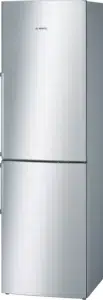Loading ...
Loading ...
Loading ...

en-us
11
Super cooling
Super cooling cools the refrigerator compartment as
cold as possible for approx. 6 hours. Then the
appliance automatically switches to the temperature set
prior to super cooling mode.
Switch on super cooling mode, e.g.:
■ before placing large quantities of food in the
compartment.
■ for the fast cooling of drinks.
Switching on and off
Press button „super refrigerator“.
The button is lit when super cooling is switched on.
Freezer compartment
Using the freezer compartment
■ To store deep-frozen food.
■ To make ice cubes.
■ To freeze food.
Note:
Ensure that the freezer compartment door has been
closed properly. If the door is open, the frozen food will
thaw. The freezer compartment will become covered in
thick ice. Also: waste of energy due to high power
consumption!
Freezing and storing food
Purchasing frozen food
■ Packaging must not be damaged.
■ Use by the “use by” date.
■ Temperature in the supermarket freezer must be
0 °F or lower.
■ If possible, transport deep-frozen food in
an insulated bag and place quickly in the freezer
compartment.
When loading products
■ Preferably freeze large quantities of food in the top
compartment, where food freezes particularly quickly
and therefore also gently.
■ Place the food over the whole area
of the compartments or the frozen food containers.
Note:
Food which is already frozen must not come into
contact with the food which is to be frozen. If
required, move the frozen food to the frozen food
container.
Storing frozen food
Insert frozen food container all the way to ensure
unrestricted air circulation.
If large quantities of food are to be stored in the freezer,
all the frozen food containers (except the bottom one)
can be taken out of the appliance and the food stacked
directly on the freezer shelves.
To remove a frozen food container, pull out all the way,
lift at the front and remove.
Freezing fresh food
Freeze only fresh and undamaged food.
To retain the best possible nutritional value, flavor and
color, vegetables should be blanched before freezing.
Eggplants, peppers, zucchini and asparagus do not
require blanching.
Literature on freezing and blanching can be found in
bookstores.
Note:
Keep food which is to be frozen away from food which
is already frozen.
■ The following foods are suitable for freezing:
Baked goods, fish and seafood, meat, game, poultry,
vegetables, fruit, herbs, eggs without shells, dairy
products such as cheese and butter, ready meals
and leftovers such as soups, stews, cooked meat
and fish, potato dishes, soufflés and desserts.
■ The following foods are not suitable for freezing:
Vegetables that are usually consumed raw, such as
lettuce or radishes, eggs in shells, grapes, whole
apples, pears and peaches, hard-boiled eggs,
yoghurt, soured milk, sour cream, crème fraîche and
mayonnaise.
Packing frozen food
To prevent food from losing its flavor or drying out,
place in airtight containers.
1.
Place food in packaging.
2.
Remove air.
3.
Seal the wrapping.
4.
Label packaging with contents and date of freezing.
Suitable packaging:
Cling wrap, tubular film made of polyethylene,
aluminum foil, freezer containers.
These products are available from specialist outlets.
Unsuitable packaging:
Wrapping paper, greaseproof paper, cellophane, bin
liners and used shopping bags.
Items suitable for sealing packaged food:
Rubber bands, plastic clips, string, cold-resistant
adhesive tape, etc.
Bags and tubular film made of polyethylene can
be sealed with a film heat sealer.
Loading ...
Loading ...
Loading ...
